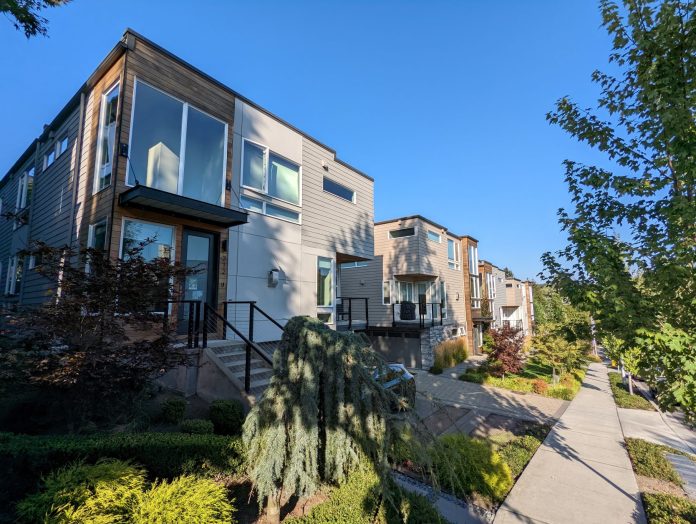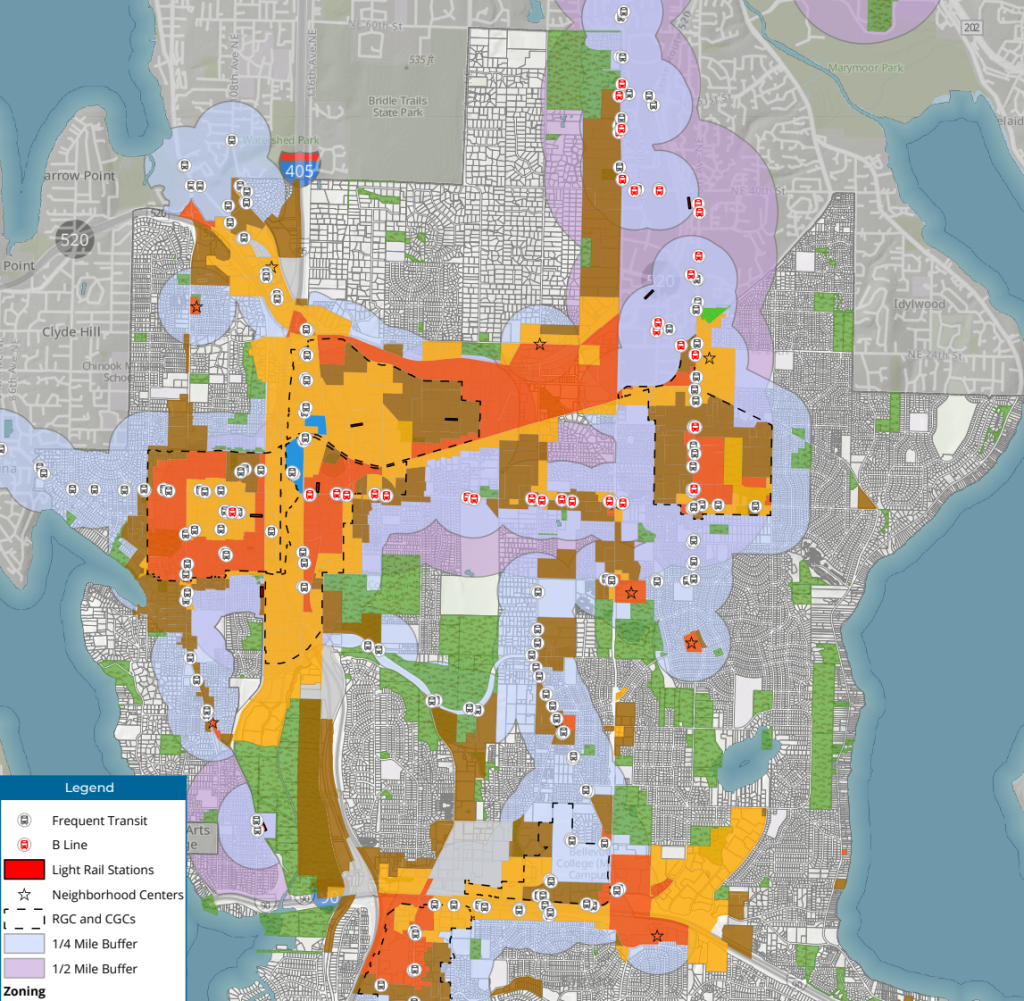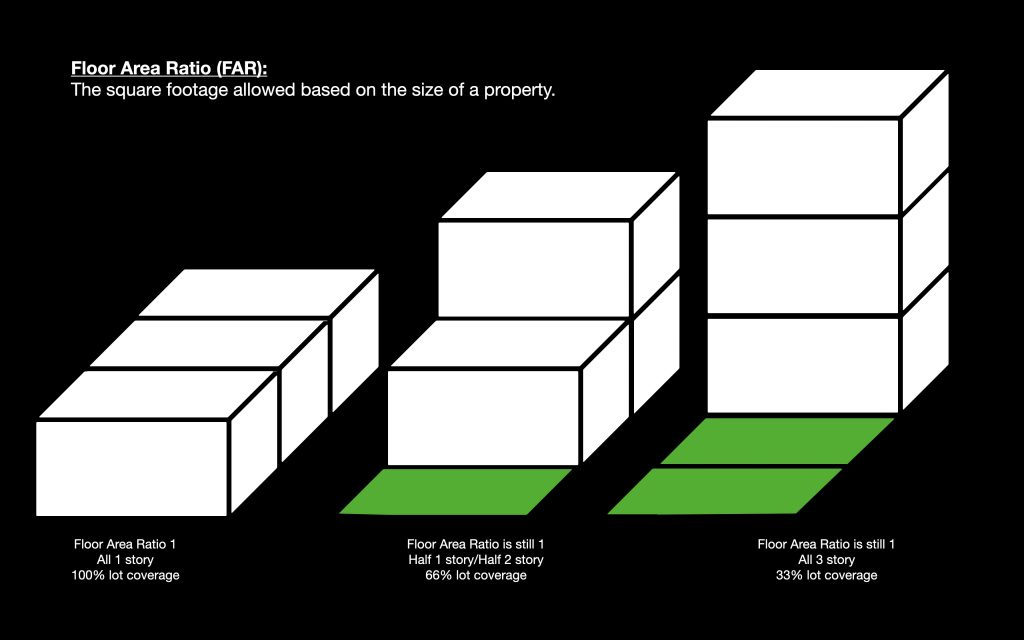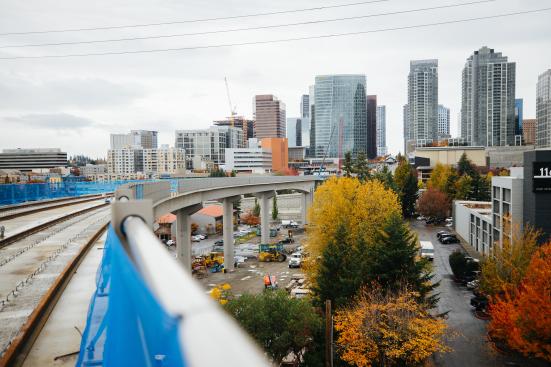
Bellevue walked back a nineplex plan, but would allow sixplexes broadly. The city’s planning commission is under pressure to further scale back the plan.
The City of Bellevue is on track to take new state requirements to allow additional homes in low-density neighborhoods and run with them, going above and beyond in a bid to add to the city’s housing stock and increase affordability. The framework would allow up to six units on residential lots across the city close to frequent transit and near growth centers.
Bellevue’s plan stands in stark contrast with interim legislation on deck in Seattle that was designed to meet those state requirements but go no further. Seattle’s permanent legislation would go beyond state requirements in a few ways, but the City put the proposal on ice pending the outcome of legal challenges from homeowner groups. Either way, Bellevue would allow sixplexes by right much more broadly than Seattle has contemplated.
House Bill 1110, approved by the state legislature in 2023, was intended to encourage the development of “missing middle” housing: types of new homes between a single family house and a large apartment building, like duplexes, triplexes, cottage housing, and rowhouses. It requires large cities like Seattle and Bellevue to allow up to four housing units on all residential lots citywide, and up to six units within a quarter-mile of light rail and RapidRide bus stops. Cities across the entire region face a deadline of June 30 to approve these changes, or a state-imposed model code would automatically take effect.
But a proposed code update under review right now by Bellevue’s Planning Commission would go even further, extending the areas where sixplexes would be allowed by-right to a half-mile within light rail and RapidRide stations, and also allow sixplexes within a quarter mile of all of the city’s major commercial hubs and other frequent buses. The changes go beyond what was initially envisioned in Bellevue’s ambitious Comprehensive Plan, adopted last year. Doubling the radius from transit stops, quadruples the area where sixplexes would be allowed.

The proposal would legalize sixplexes across large swaths of Bellevue, building on the work underway to create denser neighborhoods close to the city’s light-rail stations and adding the potential for new residents to live near high-amenity locations.
Outside of those areas, builders could add six units to a lot if two of those units are set aside as affordable housing. The on-site performance option was a stipulation of HB 1110, but Bellevue uniquely is proposing to offer an in-lieu fee option that builders could pay to subsidize the creation of affordable homes elsewhere instead of providing them on site. That fee, proposed at $150,000 per unit, could ultimately lead to more affordable housing compared with the original incentive to provide those affordable units on site.

The average price of a single-family home in Bellevue is skyrocketing and sky high at $1.7 million, which both underscores the need for middle housing and represents a major hurdle to creating it, since acquiring property is not cheap in such an environment. Allowing more homes per lot helps tip the scales toward builders choosing to build a multiplex rather than simply renovate or do a tear down for a multi-million-dollar mansion.
Bellevue’s proposal also allows additional development capacity for builders choosing to add more homes on a lot. Bellevue’s sixplexes could be 25% larger than Seattle equivalents, based on current proposals, allowing room for more bedrooms.
The way Bellevue achieves is by granting more floor area ratio (FAR) for projects with more units (only on lots that are below 10,000 square feet). FAR represents how much space all of the floors of a building are allowed to take up, compared to the total size of the lot: a two-story building taking up exactly half of a lot has an FAR of 1.0, for example. Whereas Seattle’s proposal limits builders to 1.2 FAR when building four or more units, sixplexes on lots below 10,000 square feet in Bellevue would be allowed to utilize up to 1.5 FAR.

Bellevue’s code isn’t more flexible than Seattle’s draft code in every way. Builders in Bellevue would be limited to building structures on 40-45% of a lot compared to 50% in Seattle, even as Bellevue proposes to exempt covered parking from FAR and allow builders to cover up to 65% of a lot in impervious surfaces. Cottage housing projects in Bellevue would be allowed to utilize 5% more of a lot, however.
Initially, Bellevue’s middle housing code had been even more ambitious, with up to nine units allowed by-right near frequent transit and near growth centers. That was too ambitious for the Planning Commission, which asked for it to be scaled back to six units in March. At that time, the commission also got more strict about the definition of walking distance, potentially cutting out properties that would otherwise have been included.
Now the commission is set to make a final recommendation later this month, and the big question is: will they scale things back any further?
“I continue to have grave concerns about that, in what are now residential areas,” commission chair Craighton Goeppele said last month. “I can get my head around, you know, the four or six units, I cannot get my head around nine units. I feel like that’s going to have such a incredible impact on the nature of these neighborhoods, that I don’t think is sustainable.”
At a public hearing that stretched to over two hours on Wednesday night, the commission heard an extensive amount of testimony against the proposed changes, with commenters bringing up potential impacts on Bellevue’s suburban character as well as concerns around increased traffic and lack of required parking. Under HB 1110, Bellevue can’t require any off street parking with middle housing within a half mile of light rail or RapidRide stations. Numerous speakers urged the commission to go no further than the state-imposed bare minimum.

“We need to be thinking more about traffic, water, sewer, electricity, excessive on-street parking,” said Paul Clark. “We shouldn’t be proceeding with anything beyond the state mandated changes without first ensuring our neighborhoods will have reliable infrastructure, utilities, [and] that we won’t face gridlock on our local streets.”
Clark has filed to run for Bellevue City Council on a platform of “protecting neighborhoods,” after unsuccessfully running in 2023.
“Should an enhanced middle housing [land use code amendment] pass, it will be open season on the single family home neighborhoods,” Newport Hills resident Heidi Dean said. “Those investors will move in. They already are. We will cease to exist as connected communities. And so I beg you do not condemn us to that fate.”
But the commission also heard from plenty of Bellevue residents asking for the city to remove barriers to more housing.
“Bellevue has become increasingly unaffordable for families,” Valentina Vaneeva said. “I strongly support staff’s recommendations, but I also want to say that I’m very disappointed by the proposed reduction in the number of allowed units and a decreased distance from transit stops. These changes undermine our ability to create the inclusive and connected Bellevue that truly welcomes all, including people of lower incomes.”
While the current version of draft code is much more ambitious that many other peer cities, including Seattle, there’s no guarantee that it will remain as ambitious by the time it reaches the Bellevue City Council later this year. In theory, councilmembers could vote to overrule the planning commission’s recommendation, but they rarely do so in practice.
The next meeting of the Bellevue Planning Commission is scheduled for April 23, and the entire commission can be reached at planningcommission@bellevuewa.gov.
Ryan Packer has been writing for The Urbanist since 2015, and currently reports full-time as Contributing Editor. Their beats are transportation, land use, public space, traffic safety, and obscure community meetings. Packer has also reported for other regional outlets including Capitol Hill Seattle, BikePortland, Seattle Met, and PubliCola. They live in the Capitol Hill neighborhood of Seattle.


